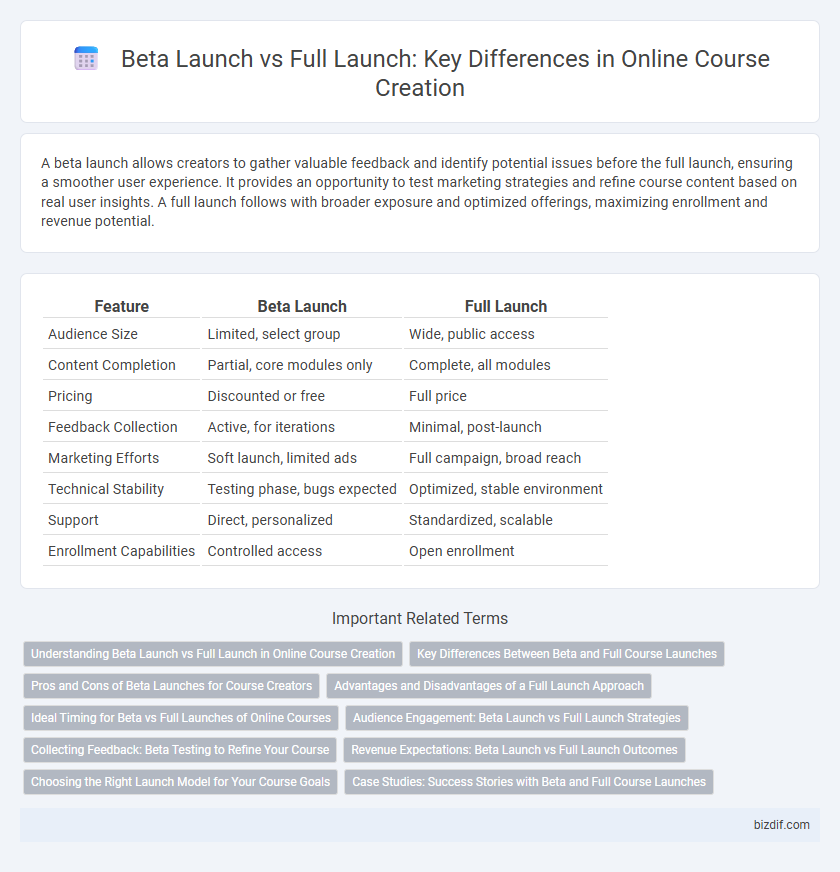A beta launch allows creators to gather valuable feedback and identify potential issues before the full launch, ensuring a smoother user experience. It provides an opportunity to test marketing strategies and refine course content based on real user insights. A full launch follows with broader exposure and optimized offerings, maximizing enrollment and revenue potential.
Table of Comparison
| Feature | Beta Launch | Full Launch |
|---|---|---|
| Audience Size | Limited, select group | Wide, public access |
| Content Completion | Partial, core modules only | Complete, all modules |
| Pricing | Discounted or free | Full price |
| Feedback Collection | Active, for iterations | Minimal, post-launch |
| Marketing Efforts | Soft launch, limited ads | Full campaign, broad reach |
| Technical Stability | Testing phase, bugs expected | Optimized, stable environment |
| Support | Direct, personalized | Standardized, scalable |
| Enrollment Capabilities | Controlled access | Open enrollment |
Understanding Beta Launch vs Full Launch in Online Course Creation
A beta launch in online course creation involves releasing a preliminary version of the course to a limited audience to gather feedback and identify potential issues, allowing creators to refine content, fix bugs, and enhance the user experience before a full launch. The full launch is the official release of the course to the broader market, supported by finalized materials, polished delivery, and optimized marketing strategies to maximize enrollment and revenue. Understanding the differences between beta and full launches helps course creators strategically test, improve, and successfully scale their offerings.
Key Differences Between Beta and Full Course Launches
A beta launch is a preliminary release of an online course aimed at a smaller group to gather feedback, identify issues, and make improvements before the full launch. Full course launches target a broader audience with polished content, finalized materials, and robust marketing strategies designed to maximize enrollments and revenue. Key differences include the scope of audience, level of content refinement, and overall marketing investment, with beta launches prioritizing testing and iteration while full launches emphasize scalability and customer acquisition.
Pros and Cons of Beta Launches for Course Creators
Beta launches offer course creators valuable early feedback and user insights, enabling content refinement before the full launch and reducing the risk of unresolved course flaws. They allow for controlled, smaller audiences, minimizing negative reviews while testing technical platforms and engagement strategies. However, beta launches may generate limited initial revenue and require additional time investment for iterative improvements based on participant feedback.
Advantages and Disadvantages of a Full Launch Approach
A full launch approach in online course creation maximizes initial revenue potential by targeting a broad audience and leveraging comprehensive marketing strategies, ensuring rapid brand visibility and feedback. This method demands significant upfront investment in content development and promotional activities, increasing financial risk if enrollment targets are not met. The full launch also limits the ability to iterate based on early user feedback, potentially impacting course quality and student satisfaction compared to phased rollouts like beta launches.
Ideal Timing for Beta vs Full Launches of Online Courses
The ideal timing for a beta launch of an online course typically occurs 4 to 6 weeks before the full launch, allowing enough time to gather valuable user feedback and make critical improvements. Full launches should be scheduled after refining course content based on beta testers' input, ensuring a polished and effective learning experience. Properly timed beta and full launches optimize student engagement, course completion rates, and overall success.
Audience Engagement: Beta Launch vs Full Launch Strategies
Beta launch strategies prioritize gathering valuable feedback from a smaller, targeted audience to refine course content and enhance user experience before the full launch. Full launch strategies focus on maximizing reach and engagement through comprehensive marketing campaigns and scalable support systems to accommodate a broader audience. Leveraging initial beta user insights boosts content relevance and increases overall audience retention during the full launch phase.
Collecting Feedback: Beta Testing to Refine Your Course
Beta launch enables course creators to gather valuable learner feedback that highlights areas for improvement and content clarity. This phase allows testing of course materials, platform functionality, and engagement strategies, ensuring a polished experience. Addressing feedback during beta testing increases course effectiveness and learner satisfaction before the full launch.
Revenue Expectations: Beta Launch vs Full Launch Outcomes
Beta launches typically generate initial revenue from a smaller, targeted audience paying early adopter prices, providing valuable cash flow and market validation. Full launches aim for maximum revenue by reaching a broader customer base with polished content and scaled marketing efforts. Expect revenue during beta to be modest but critical for refining the course, while the full launch usually drives significant income growth and profitability.
Choosing the Right Launch Model for Your Course Goals
Choosing between a beta launch and a full launch depends on your course goals and target audience readiness. A beta launch enables collecting valuable user feedback, refining content, and building initial testimonials before a wider release. In contrast, a full launch targets maximum reach and revenue but requires polished content and robust marketing strategies to ensure success.
Case Studies: Success Stories with Beta and Full Course Launches
Case studies of beta launches reveal critical insights into user engagement, course content refinement, and market fit, often resulting in a 30-50% higher completion rate post full launch. Successful full launches leverage feedback from the beta phase, leading to a 20% increase in enrollment and a significant boost in student satisfaction scores. Analyzing data from platforms like Teachable and Thinkific shows that courses with structured beta phases experience up to 40% faster revenue growth compared to immediate full launches.
Beta launch vs Full launch Infographic

 bizdif.com
bizdif.com